'How to Amsterdam' - an unexpected manifesto
The local perspective on Amsterdam City Council's unforeseen tourism reforms
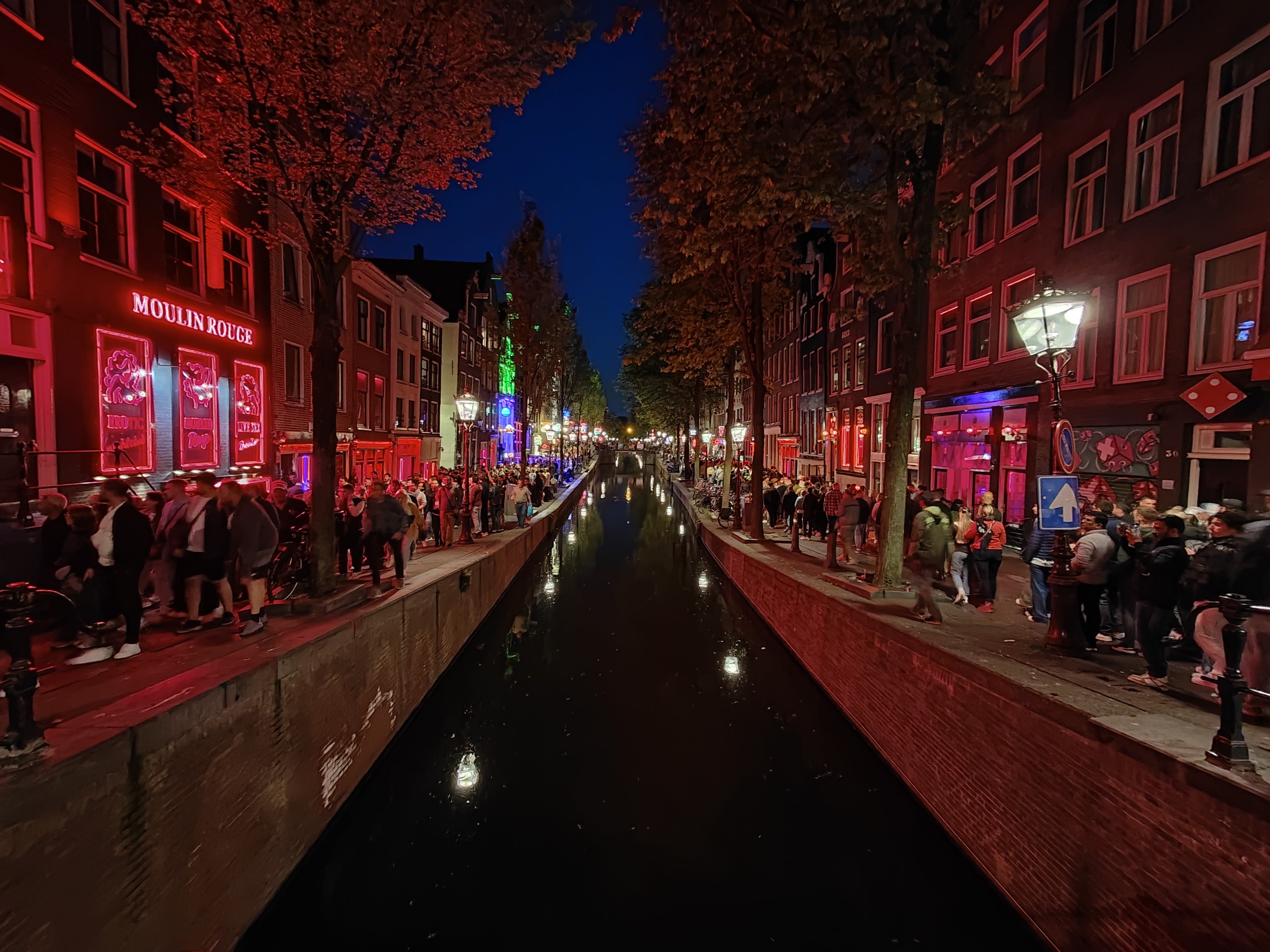
In early 2023, The Amsterdam City Council started a digital campaign against British tourists visiting the Amsterdam Red Light District area. This campaign was formed based on the nuisance created by tourists, especially from the United Kingdom. The digital campaign aired on social media platforms that showed a British tourist being arrested.
Throughout the decades, the De Wallen district (Red Light District) has been a popular destination for those looking to purchase hash or marijuana and the sex windows. Apparently, the Amsterdam City Council is concerned about the city's image and is considering executing a few unexpected changes.
- A proposal to relocate the Red Light District (Sex Workers/Erotic centre) in three areas.
- Penalising tourists who consume alcohol or smoke hash/marijuana in the Red Light District.
- Promoting ‘Stay Away,’ a social media campaign in early 2023 targeted to limit the number of British tourists.
Locals have raised concerns about the impact on Amsterdam’s tourism industry if Amsterdam City Council implements these changes to alter the city’s liberal reputation. Uncertainty also arises about the effects on sex workers and the businesses operated by cannabis-themed establishments, including museums, coffee shops, and bars.
To gain insight into the planned alterations the Amsterdam City Council made, I interviewed sex workers, citizens, museum managers, and people based in Amsterdam to uncover their views. My research is based on the following facts I learned during my time in Amsterdam, many of which the public, including tourists, are unaware of.
1- Prostitution or sex work is legal in Amsterdam
The government of the Netherlands recognises sex as a basic human need and therefore legalises it.
2- The Red Light District area is residential.
The popular De Wallen district (Red Light District) is a residential area with sex windows.
3- The sale and consumption of Cannabis (Hash and Marijuana) is formally illegal in Amsterdam.
However, the Dutch government states that these drugs pose fewer health hazards than hard drugs and that only licensed cannabis shops and coffee shops can sell cannabis products. Anyone should not possess more than 5 grams of cannabis. And now, it is illegal to smoke hash and marijuana in the Red Light area.
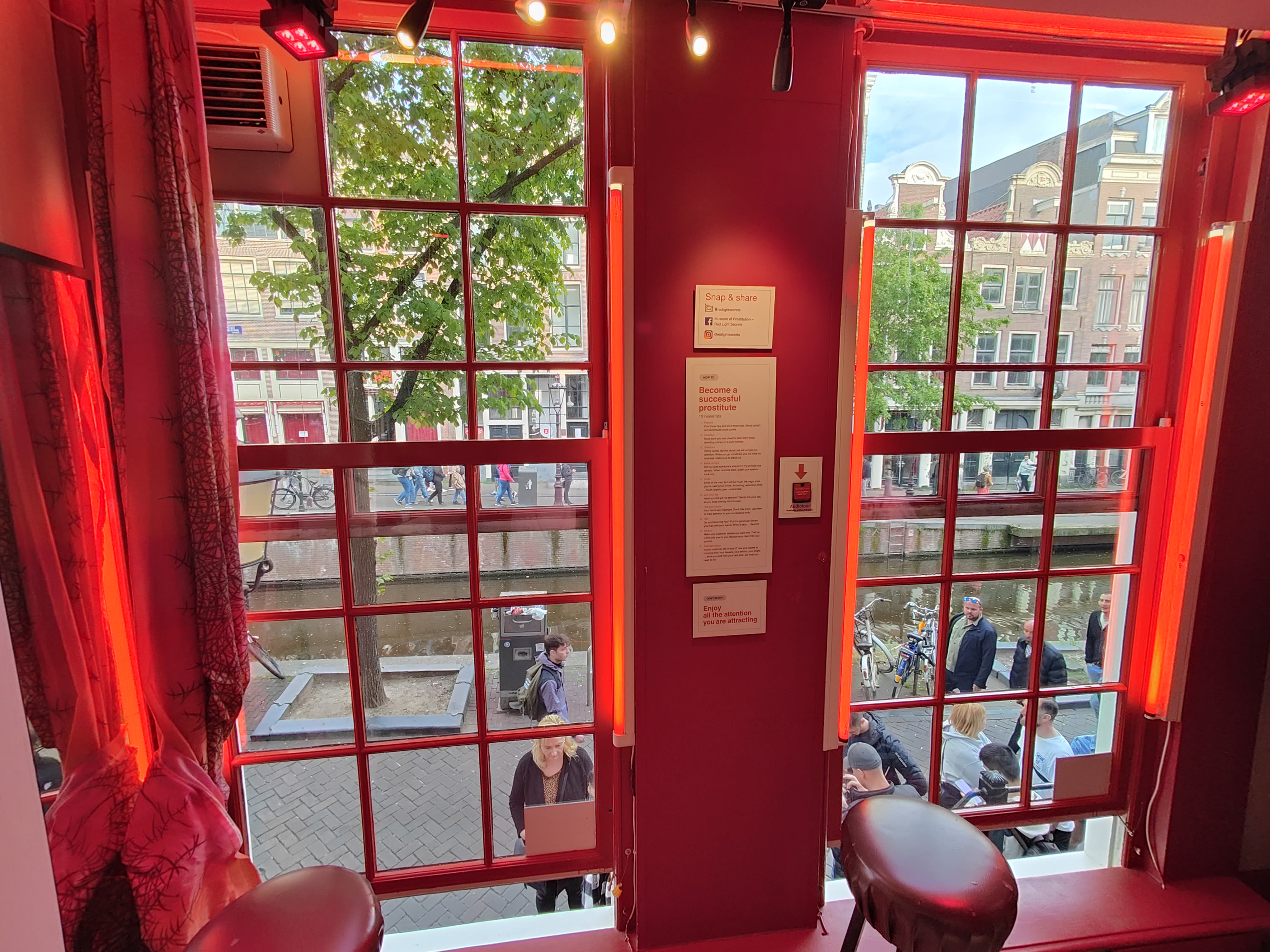
Outside view from the sex windows in Red Light District
Outside view from the sex windows in Red Light District
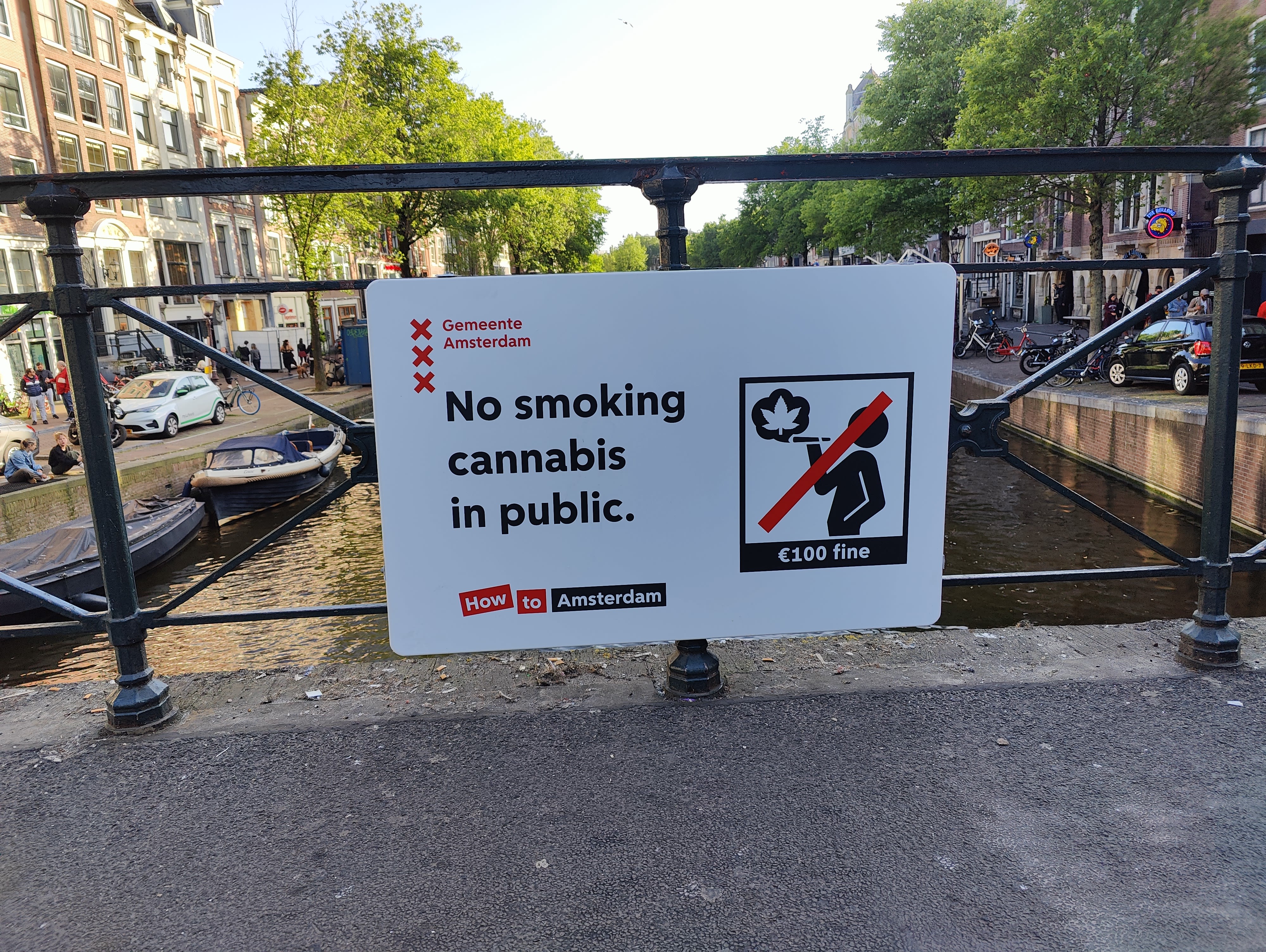
No smoking banner put up for tourists in Red Light District
No smoking banner put up for tourists in Red Light District
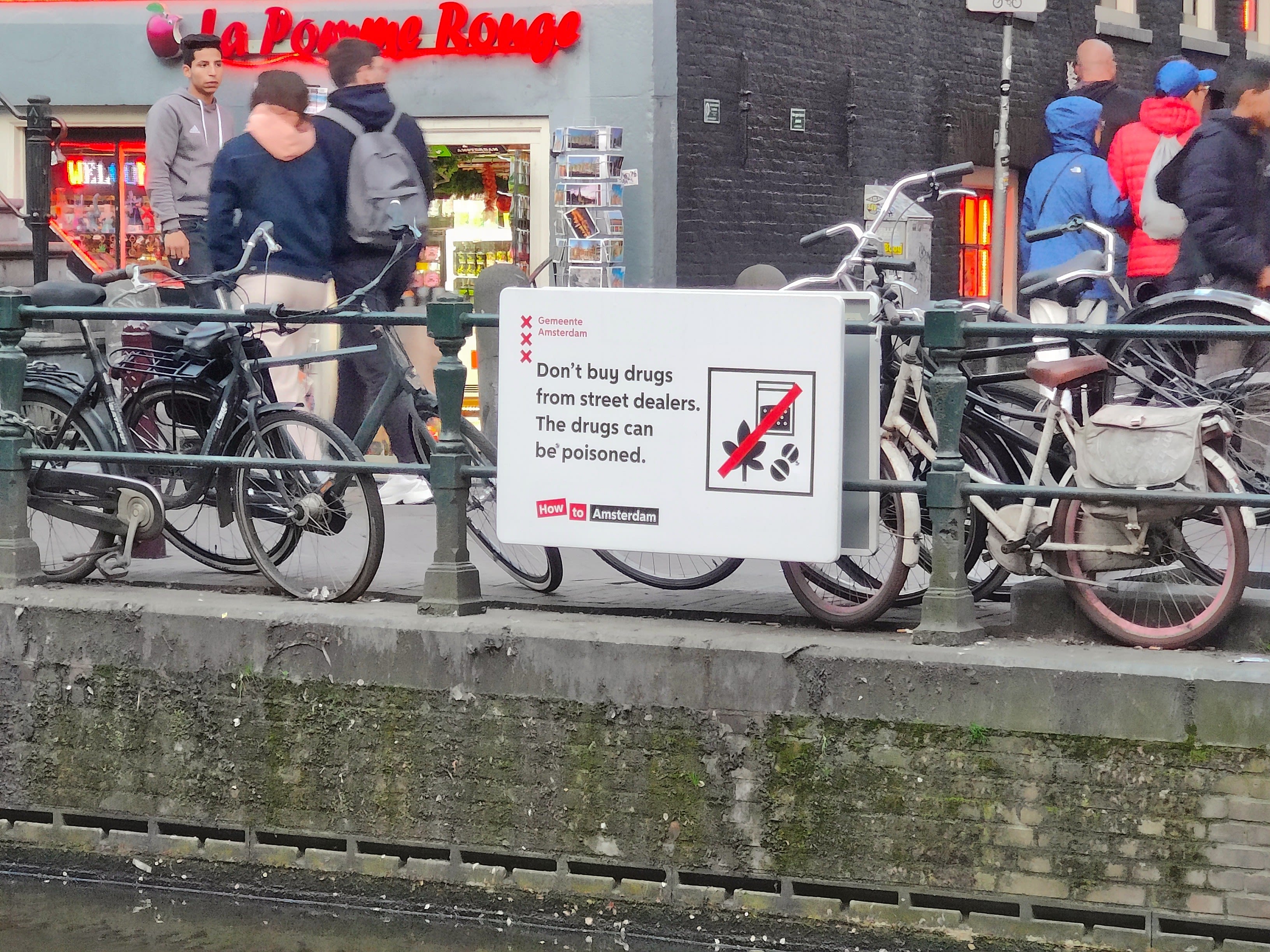
Don't buy drugs banners on streets
Don't buy drugs banners on streets
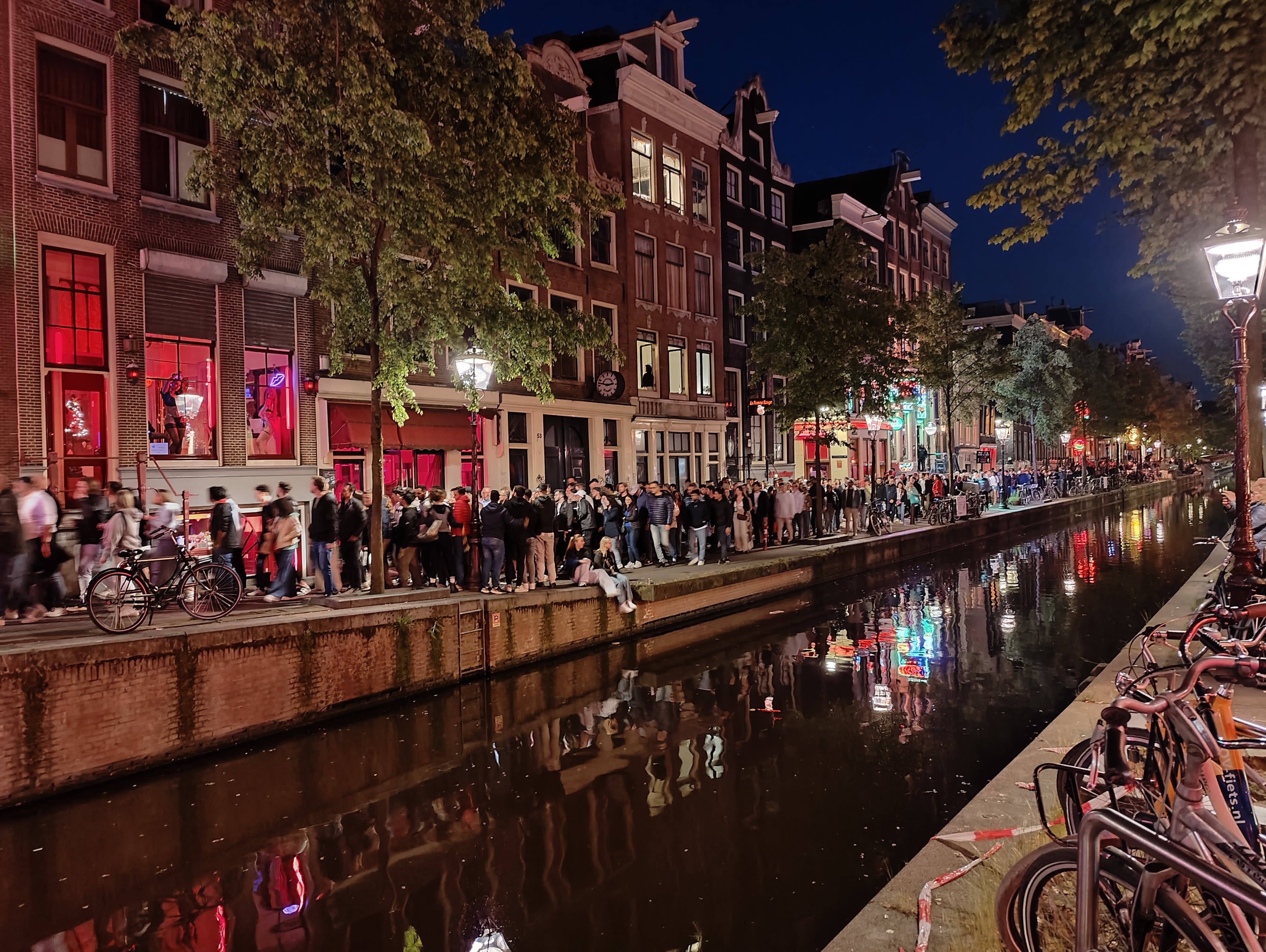
Busy street with tourists in Red Light District
Busy street with tourists in Red Light District
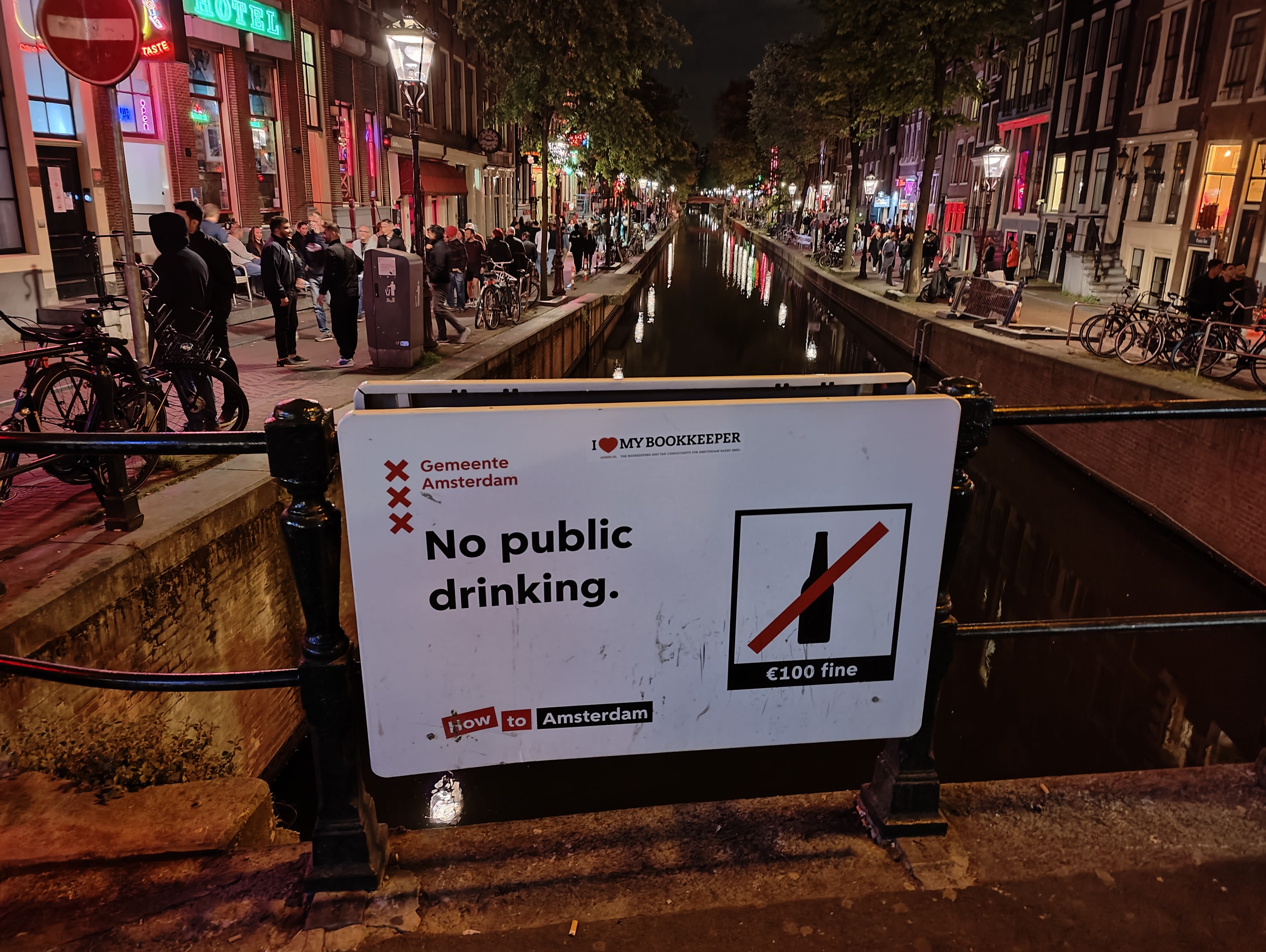
No public drinking banner
No public drinking banner
“British people are a problem here in Amsterdam because they are not tourists. Many of them are not coming to Amsterdam for Amsterdam but for other reasons, such as booze, drugs, and prostitution. There was never a problem before, but the cheap flights made travelling more easily in groups, and Amsterdam became a victim of this kind of tourism. And British tourists create a lot of trouble because they come in groups and are huge drinkers. They walk about here in the city centre as if they own this place of the city and not the people that live here”, says Bert Nap, author, historian, lecturer, and a resident of the Red Light District since 1978.
He believes that tourists should not come just to have a party. People should be welcomed in Amsterdam if they are interested in the city and its citizens. According to him, British visitors aged 20 and 40 with stag parties make a lot of noise and trouble in the area.
“Every city promotes the history and museum face of the city; however, people assume Amsterdam is a liberal city with no laws and boundaries. We are known for our tolerance, and it means that you respect one another.” Bert adds.
Amsterdam has many coffee shops selling soft drugs and magic mushrooms, and even the typical tourist shops are filled with cannabis cookies, but Bert says, “It gives the image that this is our national food.”
Bert believes that not everyone favours relocation and penalises people, but bringing back normalcy to Amsterdam is necessary.
“I don’t think it will happen because nobody wants it elsewhere. The prostitutes themselves don’t want it. Tourists come to Amsterdam from all over and not only from England. What are the council going to with the empty places and windows?” says Roos, resident of the De Wallen district and editor-in-chief of OpNieuw magazine.
Roos believes the council should not change the city’s image because tourism boosts the economy and creates jobs. She says, “Most people in bars, shops, and tourists in Amsterdam communicate in English, so the person creating a problem is not necessarily from the UK.”
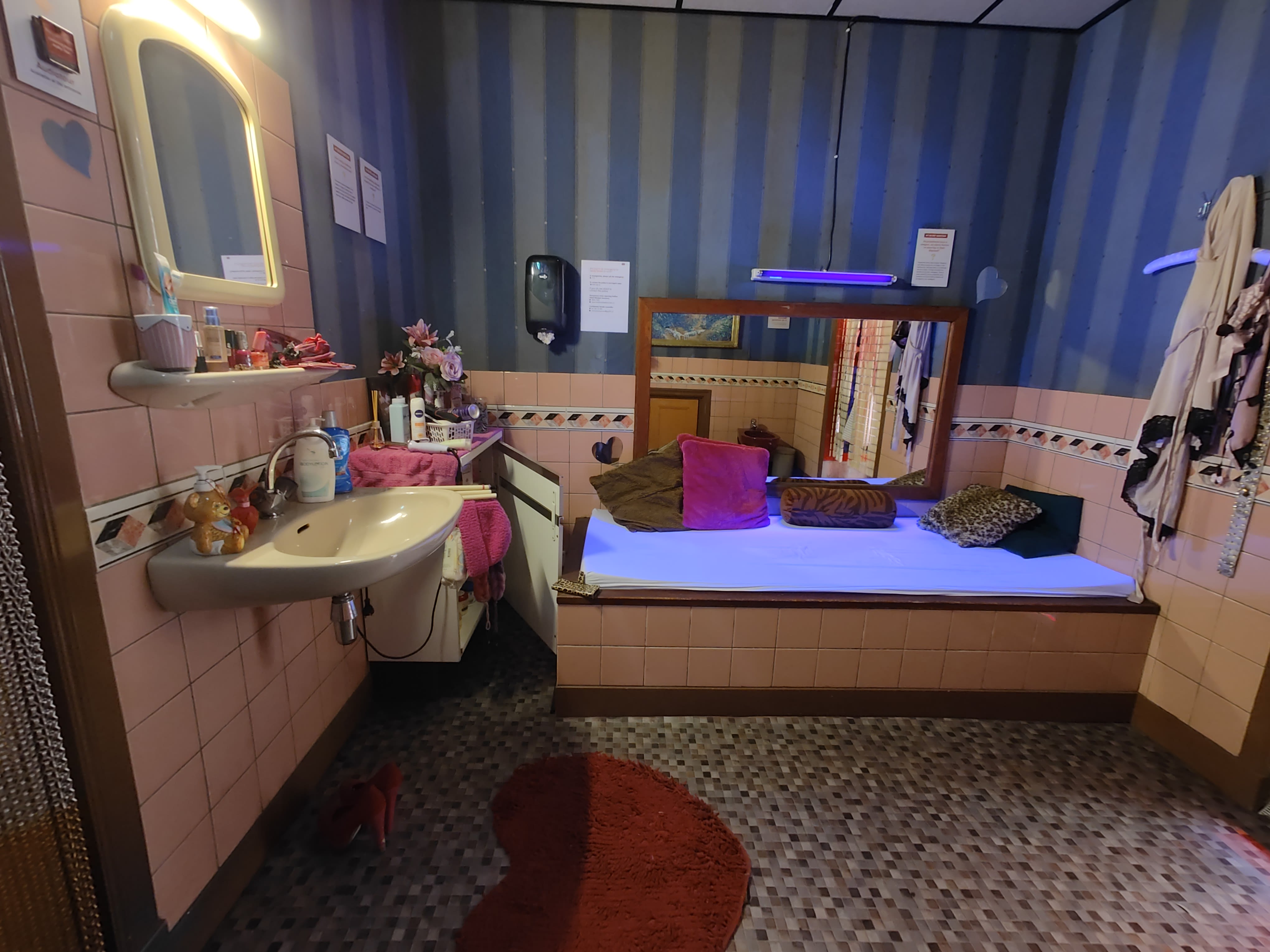
Inside a sex window: A typical room of a sex worker/prostitute
Inside a sex window: A typical room of a sex worker/prostitute
In conversation with three sex workers in the Red Light District, they believe that holding British tourists solely responsible is incorrect as people from other parts of Europe also misbehave and create a nuisance in the district.
"I won't go if the Red Light is relocated. I am happy with my life here. It is easy for me". - Monica (pseudonym), Sex worker
"I have heard this news. But it will take at least ten years to shift, which I think won't happen". -Rachel (pseudonym), Sex Worker
Phoebe (pseudonym), sex worker and coordinator from Prostitute Information Center (PIC) says, “Tourists from the Dutch provinces behave exactly like the government says the British do.”
Picture: A veteran sex worker and a policeman.
According to PIC, 93% of sex workers do not want to relocate. Certain sex workers are part of the queer or trans community who feel that this space would be safer for them. The PIC is against a well-established, historically created community of sex workers being closed out and forced into new areas with 100 windows compared to 249 existing in the district.
Contrary to what you might expect, Oude Kerk (Old Church), located right outside the PIC in the Red Light District, supports the sex worker community and does social projects with them.
Phoebe alleges that religious communities outside the Netherlands and Dutch rescue organisations backed by American NGOs disapprove of sex workers. She says, “The rescue industry in the Netherlands is bigger than the sex industry. They will go and pray outside windows and try convincing sex workers to leave sex work. Bring them coffee and cake.”
According to PIC, Dutch Christian congregations use summer school and American volunteers to rescue ladies from windows.
Tourists, rescue workers, and communities think sex workers are victims, trafficked, or forced to work by a pimp or lover boy. However, according to PIC, 99% percent of sex workers do it of their free will as a sex worker must be registered as a self-employed worker with the Chamber of Commerce in Amsterdam. And because of the promotions coming from these groups in America, there is pressure on the municipality of Amsterdam to change the rules and end up pushing sex workers into precarious situations.
WE LIVE HERE community - A community whose objective is to make visitors aware that residents live in the Red Light District and to take this into respect.
Lennard Roubos, Development consultant, resident, and a volunteer at We Live Here Community, says there were three meetings between the residents of the three proposed locations and the municipality to relocate the Red Light district. But in all three meetings, no neighbourhood favoured locating the erotic centre in their area.
He says, “The sex workers here feel more safe and secure, have social relations, and are also against relocation. So how can you enforce the industry’s move to the north or south district? I don’t see the feasibility.”
He disagrees that solely British tourists cause issues. He thinks that three magnets attract travellers to Amsterdam. First, Amsterdam has distinctive soft drinks. Second, coffee shops, bars, and restaurants sell soft drugs. The third is the sex industry, particularly the windows that are rare elsewhere.
“There are stay away campaigns in Amsterdam, but we are not interested in that kind of promotion. Indeed, the council’s focus is to divert the interest of tourists more towards quality elements of our culture like concerts, museums, exhibitions, and beautiful canal architecture. Still, it will take quite a while and quite some energy to change that”, he adds.
Femke Halsema, Mayor of Amsterdam recently proposed limiting the sale of cannabis joints to international visitors, sparking heated debate in the municipal council. If tourists are prohibited from purchasing drugs at coffee shops, she believes fewer would damage the city. Many people are concerned about the fact that by this proposition, street drug dealers would be attracted.
“About 7 million tourists stayed in Amsterdam in a hotel or Airbnb last year. On average, staying two nights per person means 50 million overnight stays. The government seems to proclaim that the upper limit should be 20 million. But that bypasses the fact that many tourists are still coming to Amsterdam maybe for a day session, and Dutch tourists are not included in the figure.”, says Lennard.
Hinse Mutter, Musician and Artistic director at Red Lights Arts and Culture Foundation, living in the Red Light area, thinks that the council is very sincere, and they do have political power now to indeed go forth with the next step of moving a lot of the windows to another location. He believes that the government is not having an honest dialogue with sex workers.
“It’s a day-to-day thing, and your behaviour as a person impacts a person who lives here. So, few residents don’t walk on certain streets anymore because it’s too busy. I know many people here who clean their porches every morning because tourists have peed on them. So that’s a big issue.”, says Hinse while stating that it is not evident that only British tourists are responsible for this bad behaviour.
It is a law in the Netherlands that people who do not live or work in the Netherlands cannot buy marijuana. Amsterdam is one of the cities that has not enforced this law but is considering implementing it. Enforcing this law will have more street drug dealers, according to Hinse.
“I think there would certainly be fewer people coming here. In this area, many people come here just to look at windows, architecture, or the museums.”, he adds.
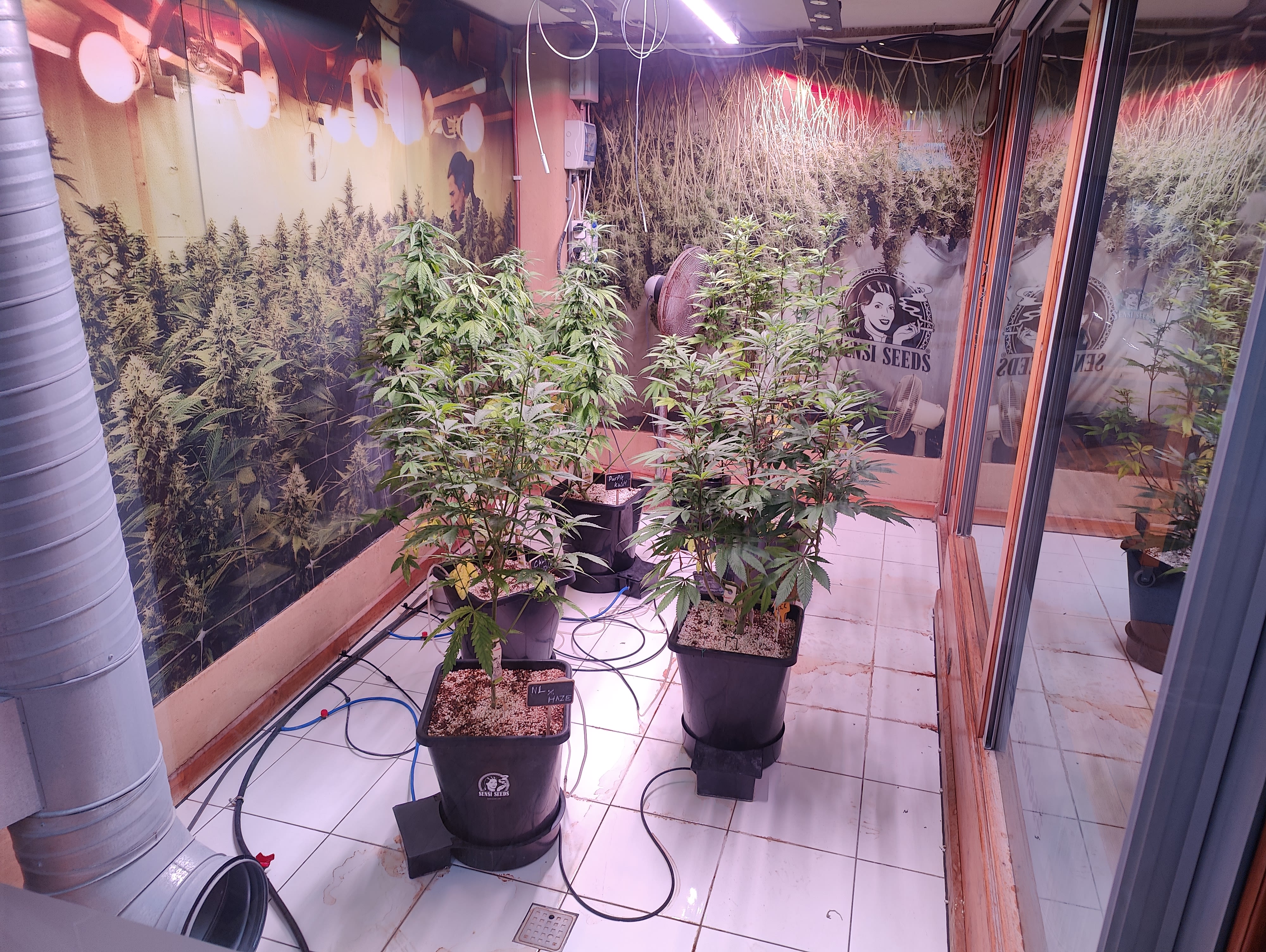
Cannabis garden
Cannabis garden
Romario, a resident in Docklandsplot, says, “To be honest, I don’t think it is a good thing that the Red Light District is shifting over here because many houses are being built here for residents. It will interfere with us living here.”
Marigold, manager at Hash Marihuana & Hemp Museum, believes that the restrictions will significantly affect the number of tourists coming to the city because Amsterdam is popular with the cannabis culture. People are allowed to smoke, and though there are other parts of tourism like the arts and museums, the tourists will be fewer if there are restrictions.
"I think that’s a good thing for the citizens, but I wonder how this will work for small businesses and the people in the cannabis and sex industry because that’s quite a large sector, and people rely on this money. The city will look better, it’s going to be less dirty, and it will attract less shady people. It’s costly to live here, and you pay to be in this place, and then some other people are just coming in, making it very bad for you. So, I understand why the council wants to change it."
She is optimistic that the council will make it legal, like in California.
Elena, social worker and co-initiator of the Red Light District festival believes that the mayor is passionate about the relocation.
She says, “It is a pity because the exciting character of the neighbourhood includes the sex workers. It’s also a heritage harbour part of town. Sex work has been here for centuries. It isn’t the sex workers’ fault; it is the way that tourists misbehave.”
She witnesses some British tourists misbehaving, peeing, or puking in the district but also states that other European tourists create a nuisance too. According to Elena, if there is a relocation, the city will lose its character and charm with no fault of the sex workers, and tourists might opt for other destinations for holidays and parties.
On the council’s plan for dealing with the illegal drug dealers, she says, “I think that there is a shortage of staff employed by the council to take care of the dealers.”
“A British guy, after having some mushrooms, operated a dog with scissors in the district. There was a bloody mess. This is why the British stand out”, says Wendy, a local tour guide. However, Wendy blames all the tourists who over-drink alcohol, creating a nuisance in the district area, and thus, the latest anti-smoking banners and laws have been put in the De Wallen district.
“Now I can’t guide the tourists anymore on the street with sex windows because the inhabitants here have said you’re bothering the ladies, which is true,” adds Wendy.
To promote Amsterdam City for arts, culture, canals, museums, and architecture, and restricting tourists by introducing a tourist tax on stays, restrictions on smoking and alcohol consumption, and relocation of sex workers, Amsterdam City will likely face fewer tourists. These propositions and laws will affect tourists' choices and the lives of sex workers, coffee shops, restaurants, bars, and people dependent on tourism. Other measures must be considered to promote the city's holistic image, and strict measures must be taken to stop illegal drug dealings and nuisance in the Red Light District rather than blaming the stag parties and making British tourists the scapegoat.
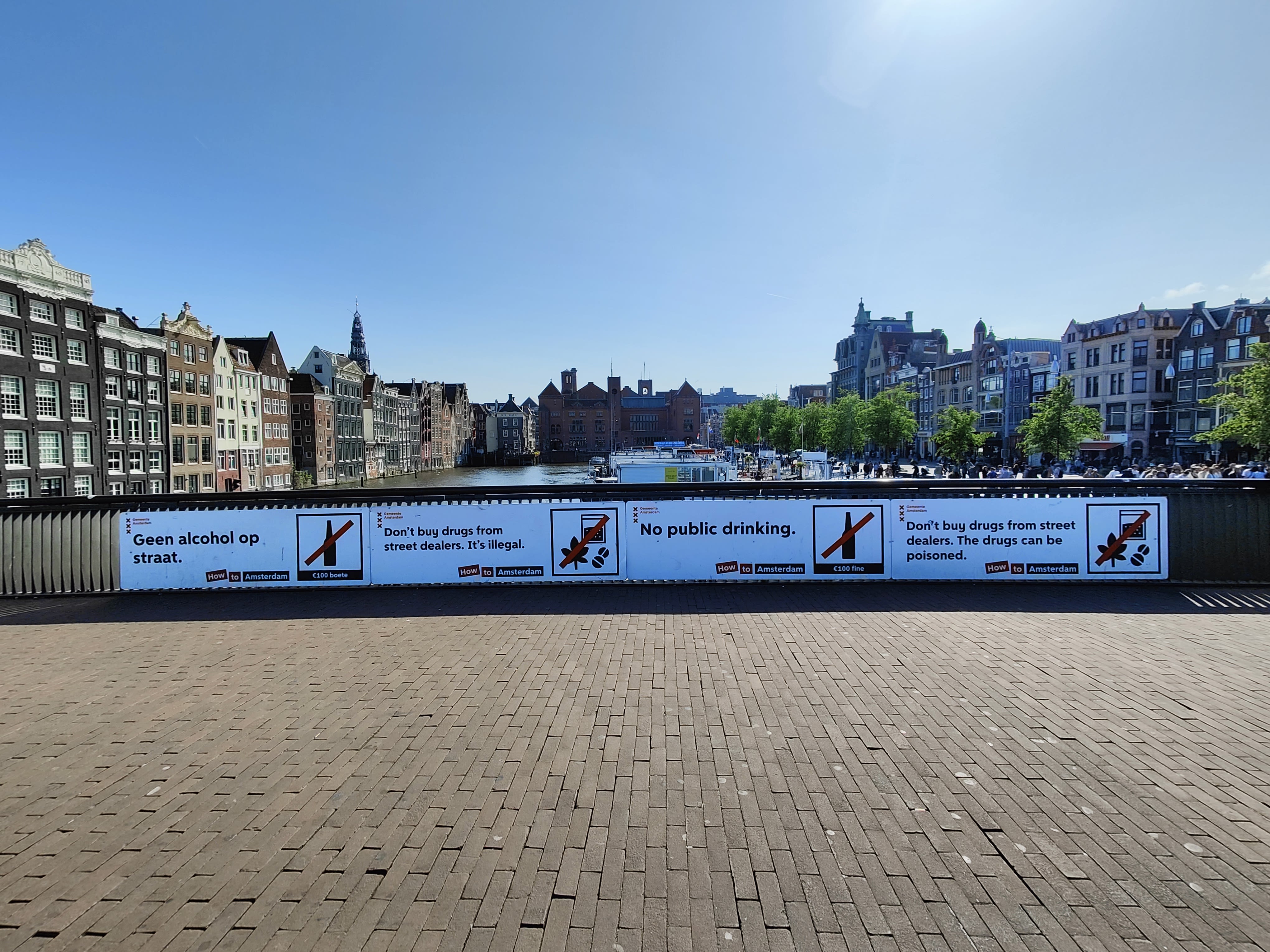
'How to Amsterdam' campaign: Anti- Alcohol, drugs and cannabis banners put up outside Central station.
'How to Amsterdam' campaign: Anti- Alcohol, drugs and cannabis banners put up outside Central station.
